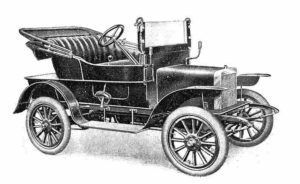As the drone industry anxiously watches federal drone laws unfold – slowly – it’s important to remember that we are at the very beginning of an emerging technology. Drone laws may seem draconian now, as the federal government struggles to focus on safety and state and local lawmakers wrestle with a public paranoid about drones. But the pace of regulation is increasing – and the commercial drone environment in the future will look very different than it does today.
You only have to look at the history of other disruptive technologies to see a pattern. The automobile is a great example – in it’s infancy, it was considered a dangerous and unreliable machine. In the late 1800’s, “Red Flag Traffic Laws” were enacted in the US and Europe: a speed limit of 4 mph was put in place for cars in rural areas; and all drivers were required to have a man waving a red flag run in front of the car. One operator was not considered enough to control a car (sound familiar, anyone?) and the UK’s “Locomotive Acts” stated:
Firstly, at least three persons shall be employed to drive or conduct such locomotive, and if more than two waggons or carriages he attached thereto, an additional person shall be employed, who shall take charge of such waggons or carriages;
Secondly, one of such persons, while any locomotive is in motion, shall precede such locomotive on foot by not less than sixty yards, and shall carry a red flag constantly displayed, and shall warn the riders and drivers of horses of the approach of such locomotives, and shall signal the driver thereof when it shall be necessary to stop…
State and local governments felt compelled to one-up the federal authorities, who were clearly not doing enough to ensure the safety of the public. One law proposed in PA said that drivers who encountered farm animals must stop the vehicle and “immediately and as rapidly as possible … disassemble the automobile”, and “conceal the various components out of sight, behind nearby bushes” until any livestock upset by the sight of a car were calmed down. Fortunately for the automobile industry, that one was vetoed.
The “Locomotive Acts” only lasted 3 years – which was about as much time as it took the automotive industry to get enough cars on the road to make them familiar. And the same will happen with drones, but this time, at a much faster pace: regulations have already changed, and will change rapidly in the future.
In a few short years, commercial drones have gone from mostly unregulated to broadly legalized.
2012: FAA Modernization and Reform Act of 2012 (Public Law 112-95) contains Section 333, which authorizes the secretary of transportation to determine whether “certain unmanned aircraft systems may operate safely in the national airspace system,” and directs the secretary to “establish requirements for the safe operation of such aircraft systems in the national airspace system.”
June 10, 2014: FAA allows the first official commercial drone flight over US soil.
September 2014: FAA begins to issue Section 333 Exemptions, which require that the PIC (Pilot in Command) hold a full commercial pilot’s license and that every operation have at least 2 people; COA must be obtained prior to flight.
February 15, 2015: the FAA publishes a Notice of Proposed Rulemaking to enact part 107 of the Code of Federal Regulations.
March 2015: FAA begins issuing blanket COAs with every exemption granted.
April of 2015: FAA starts using a “summary grant process” to expedite Section 333 Exemptions, summarily granting petitions that fall into one of 2 general categories. (Film/television and aerial data collection.)
Also in 2015: After the Grant of Petition No. 11213, the FAA changed the certification conditions, allowing sport pilots to act as PICs for commercial drone operations.
Along the way, the FAA significantly upped the pace of granting exemptions – granting 2,732 by the end of 2015. Three months later, by March of 2016, the agency was granting over 500 Section 333 Exemptions per month.
June 2016: Part 107 is (finally) announced, which will regularize commercial drone flight.
August 2016: Part 107 Enacted. Over 3,000 operators register to take the drone certificate test. Flight is not allowed at night, over people, or beyond visual line of sight (BVLOS.)
September 2016: First commercial exemptions for BVLOS, night flight, and flight over people have been granted. The first meeting of the Drone Advisory Committee (DAC), formed to help prioritize drone regulation, has taken place.
From here in the timeline, we’re speculating: but we can make some educated guesses. The FAA has promised a ruling on flight over people by the end of 2016, only a few months away; they have repeatedly acknowledged that BVLOS flight – required for many industrial applications as well as drone delivery – is also a priority.
2017: FAA allows for flight over people, regularizing the use of drones by media and security companies.
FAA allows for night flight and BVLOS flight in lightly populated areas.
2018: Integration of drones into the NAS and better communications technology allows for night flight and BVLOS flight in urban areas, drone delivery becomes regularized.
2019: The first passenger drone is legalized.
2020: Drone Taxis are regulated.
Beyond that: Who knows? Future technology will bring regulatory challenges that we haven’t thought of yet. But we’ve moved beyond the 4mph speed limit and the man waving a red flag in front of the vehicle – and the faster that drones enter the airspace and drone technology improves, the faster the regulations will evolve.
 Unmanned Aerial Vehicle The latest drone news
Unmanned Aerial Vehicle The latest drone news




